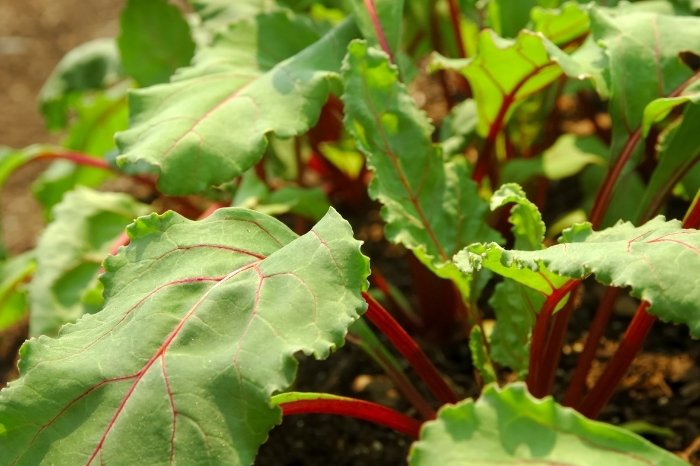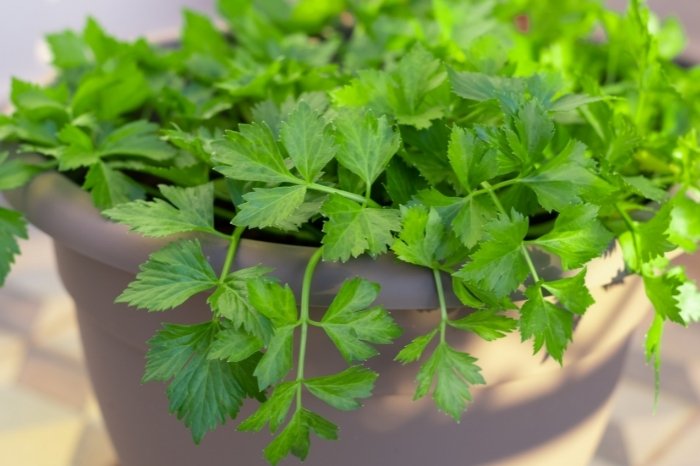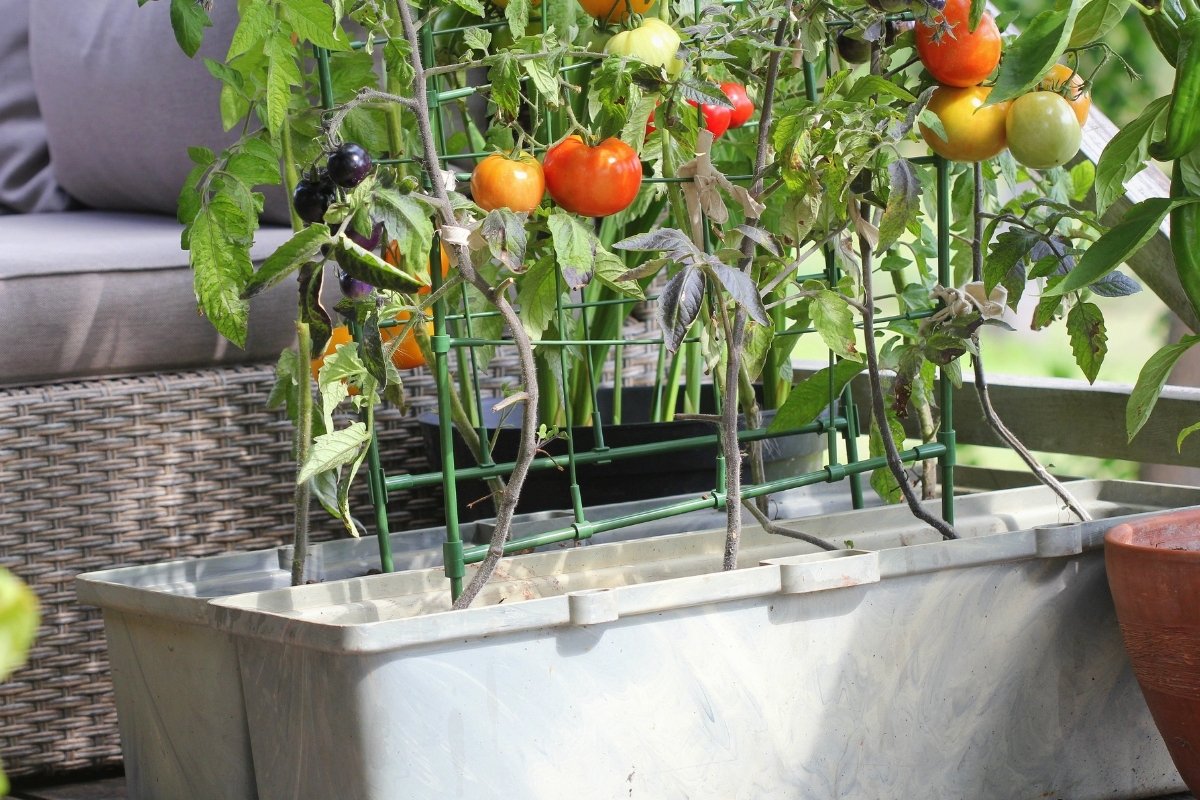Last Updated on August 30, 2022 by Griselda M.
Container vegetable gardening helps you regulate and control the conditions your plants are exposed to. In this article, we will take a look at how to grow vegetables in containers. Spoiler alert – you can grow nearly any vegetable in a container! So if you want to get going gardening, please read on.
Why Would We Grow Vegetables in a Container?
I started container gardening because of mole rats and ducks!! I used to have a small garden with a lot of ducks and golden mole rats. Ducks peck leaves and mole rats eat roots – this meant that I had nothing above the ground and nothing below the ground in my garden.
Hence I used pallets to create an elevated garden and grew everything in old 5-gallon buckets. I grew brussels sprouts, cabbages, tomatoes, potatoes, carrots, beans, peas, parsley, spinach, radish, kale, garlic, and a whole lot of other things I cannot remember now.
In some cases, the reason for us growing in containers may be different – maybe you are gardening on a balcony, or maybe your backyard is covered in concrete. Or maybe you are growing on a rooftop! Whatever the reason is, container gardening is entirely possible and actually very productive.
My current garden is half an acre, and the soil is amazing – however, I still grow a lot of plants in containers, as these just have benefits to container growth for certain plants.
So, What Vegetables Grow Well in Containers?
The following is a list of vegetables that can be grown in containers:
1. Beets and Swiss chard
These are essential garden plants. I grow both as leaf crops – beet leaves are great in stir fries and salads. Beets also produce beet roots as a useful by product. Beet root contains a lot of important nutritional and phytochemical beneficial nutrients.
You will never regret eating home grown beet root – you will feel the health. I tend to enjoy growing this variety of swiss chard as it provides a nice mixture of carotenes and other nutrients due to the various colors. For the beets, I grow Detroit Dark Red. This is just a super reliable heirloom variety, and the red color is extremely strong – the color is of course beneficial to you.

2. Broccoli
Broccoli can be grown in containers. It is best to start broccoli seeds indoors and transplant the seedlings when they are about 4-6 weeks old. If you do not have a greenhouse just buy seedlings. Make sure you choose a location with good light and good air circulation. If one is going to go to the effort of growing brocolli, try and grow a beautiful cultivar such as romanesco.
3. Brussels Sprouts
Brussels sprouts are very easy to grow in pots. They need a sunny window, lots of water and rich soil. Make sure you fertilize the plants often. Somewhat counterintuitively, it really helps to compact the soil for these plants. For most plants, a loose friable soil is good – not for brussels sprouts.
4. Cabbage
Cabbage is one of the easiest vegetables to grow in containers. It requires lots of sun, lots of water and rich soil. Make sure that you fertilize the plants often.
Cabbage is also very healthy for you. I tend to find that it is best to grow smaller baby cabbage types in pots. The purple dwarf types do very well, and produce cabbage that just tastes better than what you can buy in the shop. Plant four seeds per hole, and then when they germinate, wait a week or so and use scissors to remove the weakest seedlings and leave one strong one to grow.
5. Carrots
Carrots can be grown in containers. I always grow carrots in a soil that has had a previous crop in it before – if a soil is too rich, you can end up producing cabbages that are all green and no root. If the soil is a bit depleted, it forces the carrots to produce big roots. This is a good thing. Again, when growing carrots you have a few choices for styles.
You can sow a thick dense row of carrots – for this I normally plant kuroda. This cultivar will, if you plant it quite densely, produce baby carrots. In this growth style you make rows of carrots about two inches apart and plant seeds every inch or so.
This is dense planting, and the pot will need abundant water and good sunlight. When the carrots are ready you can pull out handfulls of lovely baby carrots.
Alternatively, if you want to grow big carrots you may as well grow something that is unusual and tasty! I tend to grow red carrots or rainbow carrots. Plant these as per the instructions on the packet.
The rainbow ones are always a bit dissapointing as the bag tends to show you this amazing variety of bright colors, and what you end up with is mainly white carrots (very dull tasting), a few yellows, a few orange and maybe one purple and one red! The purple and red taste the best.
6. Celery
Celery is very easy to grow in containers. It needs lots of sun and rich soil. If you have a large container, you can plant it on your patio or deck.
The trick with celery is to let it go to seed. The seeds are delicious, and great for cooking. The stalks can be used in stews.
You will struggle to get “shop celery” in a garden, as conditions are normally not right. This is however not a bad thing – the dark green leaves are where the magic in celery actually is! If you grow celery, you will find that sometimes it forms bunches, and keeps shooting up new baby celery from the bunch. These varieties are great because they just keep going.

7. Chinese Cabbage
Chinese cabbage is very easy to grow in pots. Make sure you choose a location with good light and good air circulation. The soil should be rich and well-drained.
This plant is a slug magnet – if you are growing it, be sure to control the slugs, otherwise you will end up with cabbage heads with holes in them and slug poop trails all around the inside of the cabbages.
8. Radishes
Radishes are a must have in a garden. They are quick, healthy and rewarding. You can literaly harvest radishes in a month at certain times of year.
This is particularly great for younger gardeners – when you are 10, time passes very slowly, and a month is a long time. Waiting two months for a carrot, is a long job for a 10 year old, waiting a month for some radishes is much better! I always actually plant a few radishes in my carrot beds – they come up in three days, and help to shade the more sensitive carrot seedlings.
In warmer weather, you cannot go wrong with cherry belle. I have grown these since I was about 8 when my parents got me into gardening. In cooler weather, Daikon or any long white radish is a good idea.
The thing that is not widely publicised about radish is that the best part of it is the leaves! Cook these in omlettes, stirfry, stews, and even in salads. You will notice some very very positive health benefits. Especially men. Well, the women will notice too.
9. Kale
Kale is a leafy vegetable that can be grown in containers. It requires lots of sun and rich soil. Make sure that you fertilize the plants often. Kale is also very healthy for you. I tend to grow the old tried and tested kale varieties such as Curled Scoth Kale, but recently, I discovered flowering kale and this is now my favorite. Why grow boring colors if you can grow multicolors!
10. Kohlrabi
Kohlrabi is a root vegetable that can be grown in containers. Make sure you choose a location with good light and good air circulation. I often find it goes to flower easily – if this happens, cut the flowers and fry them – they are delicious!
Kohlrabi is great if you grate it, together with carrots, pineapple and daikon radish and then smother it in sweet Japanese mayonaise. Truly delicious.
11. Leeks
Leeks are easy to grow in containers. They need lots of sun and fertile soil. Fertilize the plants often.
The nice thing with growing leeks in a container is that giant leeks do very well in these. When you grow leeks in a container, the trick is to only fill the container half full of soil. So you need about 5-8 inches of soil.
Try and have at least the same amount of space above the leek – as it grows, pack compost around the plant and this gives you a nice blanched stem. Do not use soil – this will get into the leek and this will give you crunchy gritty leak soup which is just horrible.
Gaea’s Blessing Seeds – Leek Seeds (1000 Seeds) Non-GMO American Flag
12. Lettuce
Lettuce is an easy vegetable to grow in pots. It grows fast and only needs a good amount of compost added to the soil. Make sure the soil is rich and well-drained.
If you are growing lettuce, be careful to choose leef letuce varieties – thes grow for a long time and are bred so that you go and pick a few leaves here and there. You get head lettuce – that you harvest in one go, and leaf lettuce. For pots, leaf lettuce gives you the best return on investment in terms of mass of useful salads harvested over time.
13. Mustard Greens
Mustard greens are easy to grow in pots. Make sure you choose a location with good light and good air circulation. The soil should be rich and well-drained.
I love this plant, and find that it really makes you feel healthy. This is better as a cool weather crop. It seems to get tough and gunky in summer.
14. Swiss Chard
Swiss chard is one of the easiest vegetables to grow in containers. Place the pot in a location with good light and good air circulation. Provide it with fertile soil that drains well. As we have mentioned above – it grows well with beets as well. I normally plant them together and just harvest leaves of both!
15. Eggplant
I find that this always grows better in a container than in the soil in my area. I have some irritating pathogens that have built up in my garden that just kill eggplant. Each year, I grow five of them in fresh pots, with fresh soil from elsewhere. This seems to let me get a nice crop. Black Beauty is a good variety to start with.
16. Turnips
Turnips are easy to grow in pots. They need lots of sun and rich soil. Make sure that you fertilize the plants often.
I have a love hate relationship with turnips. There is nearly nothing that you can do with the actual turnip that tastes good – grating it, and mixing it with butter and microwaving it until it goes golden brown is about the best it will ever taste. The leaves however are very good for you.
I grow turnips for the leaves, and cook the vegetables for my chickens. Do not feed turnip to your dogs if they sleep inside – the results will be the worst gassy emisions you can imagine.
17. Cucumbers
Cucumbers such as the cultivar Ashley grow very well in containers. If you are on a balcony, let them run along the balcony railing (assuming there is no risk of somebody getting hit by a cucumber on the street below). These are very productive, and you will get sick of them.
I find that after the first 10 or 15 of these things, I end up just using them in smoothies. You need to peel Ashely cucumbers as they have bitter skin.
18. Tomatoes
Tomatoes are easy to grow in containers as long as the container has good drainage and the soil is rich and fertile. Place the container in a sunny location for enough sunlight. Use at least a 5 to 10 gallon container for tomatoes.
In Summary – What Vegetables Grow Well In Containers
The world is a container – just a big one. All we are doing is sub dividing it into a smaller container to grow plants! So, if you choose the right size container, you can grow pretty much any plant.
The great thing with containers is you can regulate soil moisture a bit better, drainage is good, and you do not have to worry about moles eating your root vegetables!
FAQs
How deep do containers need to be to grow vegetables?
This depends on the depth of the root zone and soil type. Generally, the deeper the container, the more nutrients the roots can access. Most vegetables are grown in containers no deeper than 2 cm. For a wider range of plant choices, we recommend using 4--5 cm deep containers, as this will allow for the growth of larger plants.
What vegetables grow well in shallow containers?
Shallow containers are perfect for growing the following types of crops:
Salad greens (including lettuce, arugula and spinach), herbs, edible flowers, cucumbers, tomatoes, peppers, onions, broccoli, brussels sprouts, carrots, cabbage, cauliflower and potatoes.
What are some of the easy vegetables to grow in pots?
Easy to grow vegetables include the following: Arugula, arugula, lettuce, spinach, basil, parsley, cilantro, dill, mint, oregano, chives, thyme, rosemary, lemongrass, bay, tarragon, marjoram, chive flowers, borage, nasturtium, calendula, cosmos, daisies, peonies, dahlias, sunflowers, pansies, snapdragons, zinnias, cosmos, marigolds, and herbs such as rosemary, thyme, sage, oregano, basil, mint and lemongrass.
What vegetables can be grown together in the same container?
You can grow some vegetables together in the same pot. For example, you can grow tomatoes and peppers together in one container. You can also grow them in different containers or even in different areas of your garden. This is a great way to maximize your space and give your garden some variety. You can grow tomatoes and peppers together in the same container.
Caroline is a gardener who loves to get down to the nitty–gritty of gardening. She proudly proclaims herself as a ‘dirt worshipper‘ and can often be found deep in the garden, covered in soil and singing to her plants. As a self–proclaimed ‘plant whisperer‘, Caroline believes that plants need love and attention just like any other living thing, and she loves to give them both. When she‘s not tending to her garden, you can often find her researching the latest gardening trends, or teaching others how to make their gardens thrive


